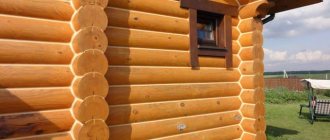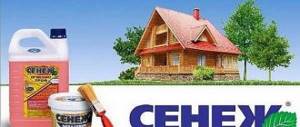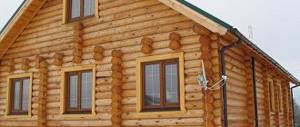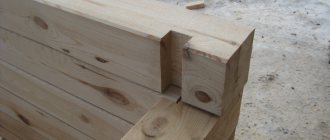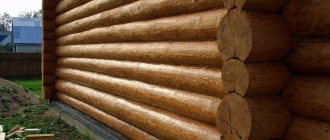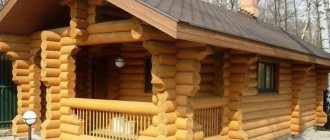Most often, when building a bathhouse, wood is chosen as the wall material. The log house looks aesthetically pleasing and does not require additional finishing outside and inside. However, the walls will need to be periodically treated with protective compounds. And many people have a question: how to treat the outside of a bathhouse? We'll talk about this further.
Treatment with protective compounds is a mandatory step in the construction of a wooden bathhouse and its subsequent operation.
Types of protective compounds and requirements for them
It should be noted right away that after treating the walls with a protective composition, the appearance of the building should not deteriorate. It is important that the wood retains its natural appeal. The protective layer should not negatively affect the technical characteristics of the wood - air permeability should remain at the same level.
Also, the protective layer must ensure that the wood can withstand atmospheric influences (precipitation, sunlight, temperature changes), fire and insect pests.
Treatment with impregnations allows you to reveal and emphasize the wood grain
All these issues cannot be solved only by treating the walls with antiseptic compounds. Only comprehensive treatment will help. Using the following means:
- Antiseptics that prevent the appearance of mold and mildew.
- Antiperenes , which increase the fire resistance of wood. During processing, the substance penetrates the top layer of wood and is released when the surface is heated, forming a protective film.
- With the help of varnishes and paints, wood can be protected from atmospheric moisture and sun. To preserve the wood texture and shade, it is recommended to use colorless compounds. Sometimes a colored pigment can be added to enhance the tone of the wood.
Expert opinion: Masalsky A.V.
Editor of the “construction” category on the Stroyday.ru portal. Specialist in engineering systems and drainage.
To ensure that the treatment is carried out evenly and there are no missed areas, tinted fire retardants and antiseptics are used. There are also colorless compositions that can be tinted if necessary.
The use of protective compounds and coatings allows you to preserve a wooden frame in its original form and extend the service life of structures. There is no other way to preserve the shade and texture of wood. Painting with alkyd compounds and varnishing is only a temporary measure. At the same time, the “breathing” ability of wood with repeated staining is significantly reduced.
The treatment of bath walls is carried out in stages:
- First, the walls need to be prepared - clean and sand the outer layer. At this stage, the damaged wood is removed, the surface becomes smooth - this will allow the impregnation to be applied evenly and ensure its maximum penetration into the structure of the material.
- Then the walls are completely treated with protective compounds several times. Each layer is applied after the previous one has completely dried.
- The last layer is designed to protect the wood from external influences (paint, varnish, stain).
Initially, the logs from which the bathhouse will be built are treated with protective compounds - antiseptics. When the log dries to the optimal moisture content, substances are applied to its ends that prevent deformation and cracking of the natural building material.
Primary processing is carried out at the stage of assembly of the structure
It is a mistake to think that this processing is sufficient. Indeed, during the construction process, logs or beams are subject to adjustment and trimming, so the finished structure also needs careful processing.
Note! The surface of the log house is processed several times. First, immediately after shrinkage. Then after two or three years. The next time occurs after four to five years, when the effect of the protective impregnations weakens.
But these are only theoretical recommendations. In fact, the protective layer weakens much faster and this depends on the climatic characteristics of the construction region.
Choosing a treatment product
A wide range of domestic and imported products are produced for processing polished surfaces. But not all of them can be used for a residential building, since some of them are unsafe. And the price-quality ratio is not always indicative.
After sanding, the walls of the house need to be coated with the following compounds:
- Antiseptics (they prevent the development of microorganisms and fungi).
- Glazing compositions (give a beautiful appearance to the walls).
- Fire retardants (increase the fire resistance of wood).
The main purpose of this treatment is protective. And modern treatments can emphasize the natural texture of the log wood or tint it. Of course, you can apply simple facade paint to the primer, but this way the wood texture will not be visible.
Initially, a primer antiseptic is applied to the sanded surface. After this, a tinting or bleaching antiseptic is used. The third layer can be coated with fire retardants.
To paint the log house, use a brush or spray gun. If the house is made of logs with an uneven rounded surface of the logs, then it is easier to cover it with a brush. Building a house from laminated veneer lumber with a flat surface involves the use of a spray gun.
It is best to prime the walls of the house with antiseptics from Tikkuril, for example Valtti Pohjuste. The average cost of this is from 2,500 to 3,000 rubles. for a 9 liter container. Valtti Pohjuste from Tikkurila is a deep penetration antiseptic that has good characteristics and user reviews.
Russian Neomid 440 has also proven itself. It penetrates the wood fibers of the log house and protects against all microorganisms known to science. Sold concentrated, separately for exterior painting. Cost of Neomid 440 from 1,200 rubles. for 10 liters.
To emphasize the woody texture of the log house, it is good to paint it with Valtti Color glazing compound from the same Tikkurila. The consumption of this composition is low, up to 9-10 m2 per liter of product.
The manufacturer offers it in 40 different shades, and is colorless. Price on average from 280 rubles/liter. Domestic Neomid Bio Color is considered a good alternative to Tikkurilla, but has fewer shades. It is produced on a water basis, so the product is considered environmentally friendly. Cost from 130 rub./liter.
To dilute any of the compositions, white alcohol is used, which is also suitable for washing tools after painting.
Finnish manufacturers Teknos have proven themselves well. Among their line, I would like to note the water-based antiseptic Teknol Aqua 1410-01. But all water-based antiseptics should not be left uncoated with another composition for more than 5-6 months.
Preparatory stage: surface grinding
Before treating wooden walls with protective compounds, as noted earlier, they are sanded. This is done in order to remove the worn, mechanically damaged top layer.
The abrasive blade of the tool cuts off several millimeters of the wood layer
This is a mandatory procedure, as a result of which it is possible to cut off the porous layer of wood saturated with moisture. If it is not removed, it will prevent the penetration of protective compounds into the wood. And the air that is in the pores will not allow you to evenly cover the wood with varnish or paint - bubbles will appear on its surface.
Sanding of logs is carried out in stages:
- First, the surface is cleaned of large loose particles and bark, if any remains, using a disk brush with metal bristles.
- Then the areas near the junction of the two crowns are polished. This part of the work has to be done manually, since the joint is difficult to access. You can use the tool at low speeds and a sandpaper attachment.
- At the final stage, the front surface of the log is polished. The tool should operate at medium speed. The diameter of the abrasive disc should not exceed 15 cm. It is necessary to carefully process the surface of the wood, cutting off a layer of no more than 2 mm.
To avoid creating unwanted defects on the surface of the logs due to inexperience, it is recommended to use a special tool - a vibrating or belt sander .
Sanding is a dusty process, so work must be done using personal protective equipment
Note! Logs are sanded every time they need to be treated with protective compounds. Each time, after removing the old layer, the wood grain appears in a new way.
Compositions for external treatment
To impregnate the walls of log and timber baths, special or universal compositions are used. The quality of the result depends on the technical characteristics of the product and compliance with the technology of its use.
Tinting varnish with wax for exterior and interior use
Wood preservatives are:
- In the form of quick-drying impregnations with a water base.
- In the form of combined formulations that simultaneously perform the function of an antiseptic and fire retardant.
- In the form of protective components in oils and varnishes.
Note! When applied, protective impregnations emit a pungent odor, so it is recommended to use personal protective equipment during operation.
Antifungal protection
Even if cedar or oak was used to build the bathhouse, the wood needs to be treated with antiseptics. The lower crowns are especially vulnerable to moisture. Russian-made compositions have a complex effect in terms of suppressing the formation and proliferation of mold, as well as destroying insect pests.
This is what mold damage to logs looks like
Imported preparations are represented by emulsions and water-based formulations. Some preparations have an acrylic or oil base. When treating logs with such compounds, you can not only provide protection against fungus, but also create a water-repellent film with a satin shine on the surface.
How to process the ends of a log house
Is it necessary to process the ends of the log house? This is a question that is being actively discussed. Experts emphasize that protection of the ends should be carried out regularly, since this is the most vulnerable spot in the entire structure.
Since moisture in logs moves toward the ends unevenly along the cross grain, this can cause tension inside. As a result, cracks will appear at the crown, which will increase over time. Therefore, protection of the ends of the frame is mandatory.
The cut itself is a suitable place for the activation of fungus and rot. To avoid the harmful effects of the environment and protect the building from destruction, it is necessary to treat the ends immediately after construction of the building.
Lime will be an excellent antiseptic for ends. It can be used on the bottom layer of logs to reduce the moisture level of the wood. When building a bathhouse, it is better to process the outside ends according to this scheme:
- Antiseptics and flame retardants. These components completely destroy all microorganisms that may be present in the tree.
- Application of anti-tar primer. It does not allow resins to escape, so there will be no red spots on the surface after painting.
- Adhesive primer. It is necessary to reduce paint consumption and enhance adhesion to the base.
- Finish paint. It is designed not only to improve the appearance of the bathhouse, but also to protect against the influence of the external environment.
Houses made of wooden beams are not only fashionable, but also comfortable, cozy, and healthy. Knowing the secrets of processing logs, you can extend the life of your structure for many years.
Application of paints and varnishes
Not every paint is suitable for painting a log house. When choosing it, they take into account, first of all, the degree of vapor permeability of the decorative layer, the type of solvent - it can be organic or aqueous, and elasticity.
The walls are treated in several layers. The color should emphasize the natural pattern and texture of the wood. Therefore, you can choose not even a tinted composition, but a translucent or transparent composition.
The main thing is that wood paint must be vapor permeable and not impede the passage of water vapor. Over time, under the influence of moisture coming from the inside, the sealed coating will collapse, become covered with bubbles and begin to peel off. Therefore, when purchasing paints and varnishes for a log house, you must carefully read the information provided by the manufacturer on the packaging. The throughput should not be less than 120 grams per m2.
Acrylic vapor-permeable varnish for exterior and interior use
An important criterion is the adhesion of paintwork materials, which ensures the strength of the decorative layer on the surface of the wood. The most suitable composition in this regard is alkyd paint.
Acrylic compositions show high vapor permeability. But when using them, it is necessary to carefully insulate the frame from the inside. Acrylic paints containing latex have greater elasticity. Silicone paint is much more expensive than acrylic varnish.
Technology for applying protective compounds
For the treatment to be effective, protective compounds are applied to the logs even before they are assembled into a log house. After the log house is assembled, re-processing is carried out.
Processing during the assembly process
Note! It is better to immediately carry out treatment with protective compounds both outside and inside the bathhouse.
Table. Instructions for treating bath walls
| Illustration | Description |
| First you need to sand and then remove dust and minor dirt from the surface. You can use a vacuum cleaner for this. Logs must be dry before processing. If the structure is old, then during the sanding process it is possible to remove areas damaged by mold and mildew. |
| At the next stage, an antiseptic is applied. You can choose any method: manual or mechanized, but the main thing is to carefully process the ends of the logs and the crown joints. To do this, you can use a brush. After applying the first layer of antiseptic, you must wait for it to dry completely. On the packaging, the manufacturer indicates the interlayer drying time of its products. Then the second and third layers are applied with a drying break. |
| After the last layer of antiseptic has dried, a fire retardant is applied. It may also contain antiseptic additives. |
| At the final stage, a protective varnish is applied. It will protect the previous layers from washing out and external influences. |
Note! On packaging with antiseptics you can often see information that the treatment provides protection for the wood for several decades to come. In fact, it is recommended to update the protective layer at least every 5-7 years.
It is recommended to start processing the log house as soon as the box is assembled. Some masters combine these two processes.
Video - The best impregnation for a log house and bathhouse
Why do you need to process a log house and how much does it cost?
External treatment of the log house immediately after the construction of a log house will preserve its appearance for a long time. This treatment includes sanding and painting with various compounds that will prevent rotting and increase the fire resistance of the wood.
Sanding a wooden house is a labor-intensive process that cannot be accomplished without special tools and skills. In addition, it takes a lot of time to process a log house. Therefore, grinding services cost a lot. Treatment with antiseptics and putty is a simpler process that you can do yourself.
On average, in large cities, polishing a log frame costs from 300 to 500 rubles/m2. Taking into account the area of the walls, you can easily calculate the cost. Treatment with antiseptics from 90 rub./m2. Prices in large cities are higher than in the provinces, but this does not mean that the quality of work is worse. You need to look for craftsmen not by price, but by reviews of acquaintances or friends. You shouldn’t order the first brigade you come across through advertisements.
If you have enough free time and you have the tools, you can do the work yourself. We’ll talk below about what material is best to use and in what order to cover the walls.
